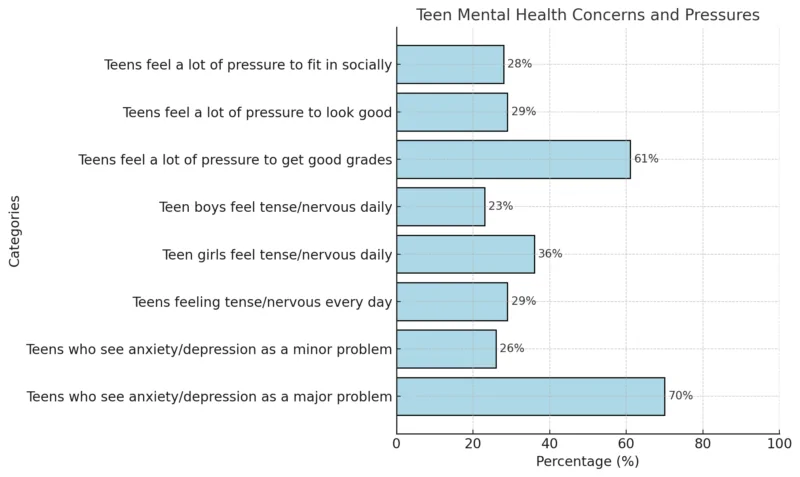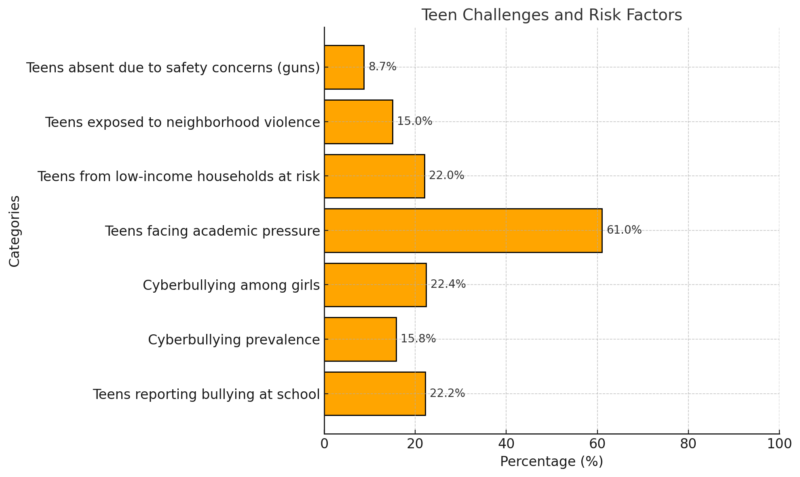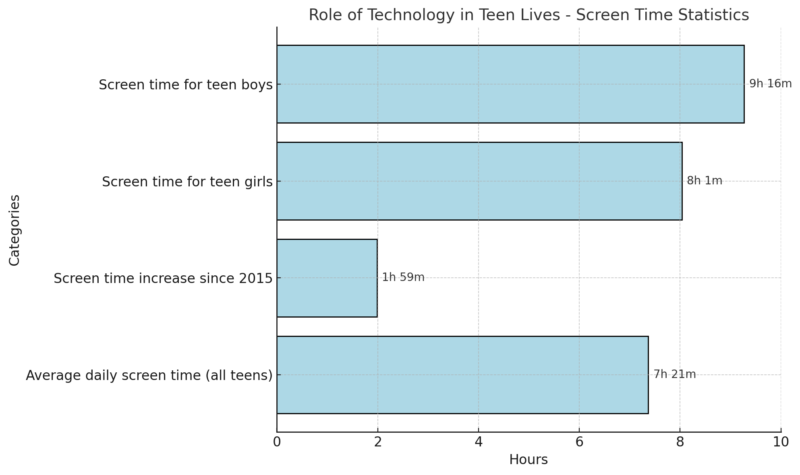Depression has been on the rise among American teenagers, with teen girls experiencing it at notably higher rates than boys.
In 2017, 13% of U.S. teens aged 12 to 17 (approximately 3.2 million) reported having at least one major depressive episode in the past year, compared to 8% (or 2 million) in 2007, according to a Pew Research Center analysis of data from the 2017 National Survey on Drug Use and Health.
Table of Contents
ToggleKey Takeaways
Depression Statistics
Category
2007
2017
Change (%)
Teenage girls with depression
1.4 million (12%)
2.4 million (20%)
+66%
Teenage boys with depression
585,000 (5%)
845,000 (7%)
+44%
Total U.S. teens with depression
2 million (8%)
3.2 million (13%)
+59%
Adults with depression
14.8 million (7%)
17.3 million (7%)
+17%
Teen girls receiving treatment
N/A
45%
—
Teen boys receiving treatment
N/A
33%
—
Adults receiving treatment
N/A
67%
—
One in five teenage girls – or nearly 2.4 million – had experienced at least one major depressive episode.
Teen girls saw a substantial increase in depression, rising from 12% in 2007 to 20% in 2017 (+66%). Boys also experienced an increase but at a slower rate, from 5% to 7% (+44%).
Overall, the total number of U.S. teens experiencing depression grew by 59% over the decade.
Over the past decade, the number of young people reporting symptoms of major depression has increased by more than 50 percent among 12 to 17 year olds, according to a study in the Journal of Abnormal Psychology. https://t.co/ew5ZsVV05b
— Here & Now (@hereandnow) March 22, 2019
Teen girls with recent depressive episodes were more likely to receive treatment (45%) compared to teen boys (33%).
Adults were more likely to receive treatment overall, with 67% of adults with depression receiving help. Women (72%) were more likely than men (58%) to seek treatment.
While the number of adults experiencing depression increased from 14.8 million in 2007 to 17.3 million in 2017, the share of the adult population affected remained stable at 7%.
Similar to teens, adult women experienced higher rates of depression (9%) compared to men (5%).
Check In With Yourself
Answer 15 simple questions to see whether your recent thoughts and feelings could point to signs of depression. The Am I Depressed Quiz offers a quick, private way to pause, reflect, and decide if it’s time to seek more support.
Disclaimer: This quiz does not replace professional advice or treatment. If you feel persistently low or have thoughts of self-harm, please reach out to a mental health professional or crisis service right away.
Teen Mental Health Concerns and Pressures: Anxiety, Depression, and Daily Challenges

A Pew Research Center survey conducted in the fall of 2018 found that anxiety and depression are significant concerns among U.S. teens aged 13 to 17. Seven in ten teens (70%) considered these issues major problems among their peers in their community, while an additional 26% viewed them as minor problems.
When asked about personal experiences, 29% of teens reported feeling tense or nervous every or almost every day, and 45% said they sometimes felt this way. Teen girls were more likely to experience daily tension, with 36% reporting it compared to 23% of teen boys.
Many teens with depression and anxiety report physical complaints, including headaches, stomach aches, and muscle tension. Others even experience unusual issues, such as ear discomfort. Learning how to relieve ear pressure from anxiety can help parents and teens recognize when physical symptoms may actually be signs of emotional distress.
Academic and social pressures contribute to these mental health challenges. According to the survey, 61% of teens felt a lot of pressure to get good grades, while around 30% experienced significant pressure to look good (29%) or fit in socially (28%).
Other Mental Health Conditions
Teen mental health statistics reveal a complex and concerning landscape that demands urgent attention.
Among the 25.8 million teens in the U.S., 42% report persistent feelings of sadness, and 22% have seriously considered suicide.
LGBTQ teens face even greater challenges, with nearly half contemplating suicide, while Native American teens experience a suicide rate 3.5 times higher than the national average.
General Teen Mental Health Statistics
Category
Statistic
Teen population in the U.S.
25.8 million
Lifetime mental illness onset by age 14
50%
Teens experiencing persistent sadness
42%
Teens seriously considering suicide
22%
Teens attempting suicide
8.9%
LGBTQ teens seriously considering suicide
45%
Native American teen suicide rate
3.5x higher than the national average
Compounding this crisis is the fact that half of all lifetime mental illnesses begin by age 14, underscoring the critical importance of early intervention and support.
Mental Health Statistics by Condition
Condition
Prevalence (%)
Additional Notes
Anxiety Disorders
31.9% of teens
Higher prevalence in girls (38%) than boys (26.1%)
Severe Anxiety
8.3% of teens
Most common in ages 17–18
Depression
20% of teens
Girls are twice as likely as boys to experience depression
Major Depressive Episode
15.1% of teens
3 in 4 teens with depression have co-occurring conditions
OCD
1 in 200 teens
70% have co-occurring disorders
Trauma/PTSD
25% experienced trauma
Girls (15%) more likely than boys (6%) to develop PTSD
Substance Use
4.1% of teens
Deaths due to overdose doubled from 2018 to 2022
Anxiety disorders, the most common mental health issue among teens, affect nearly one-third of adolescents, with the prevalence significantly higher in girls than boys according to NIMH.
Depression impacts 20% of teens, with girls twice as likely as boys to experience the condition.
Ver esta publicación en Instagram
Una publicación compartida por Youth Empowerment Success Srvs (@yess4youth)
Traumatic experiences also take a toll, as one in four teens have faced trauma, and girls are more likely than boys to develop PTSD.
Substance use is another concern, with 4.1% of teens experiencing substance use disorders, and deaths from drug overdoses doubling between 2018 and 2022 as noted by CDC. These findings highlight the interconnectedness of mental health conditions and the critical need for comprehensive care.
Social and Environmental Influences

Social and environmental factors play a significant role in teen mental health. Academic pressure is the most reported stressor, with 61% of teens feeling pressured to achieve high grades. Bullying and cyberbullying remain prevalent, particularly among girls, with 22.4% of girls reporting online harassment compared to 7.6% of boys, as shown by the results of Statista.
Teens from low-income households and unsafe neighborhoods face additional vulnerabilities, with 22% of teens in poverty experiencing mental health issues. Safety concerns, including fears of gun violence, further exacerbate stress, with 8.7% of teens reporting absences due to feeling unsafe.
Technology and Screen Dependence

The pervasive role of technology in teen lives has resulted in significant screen dependence, with teens spending an average of 7 hours and 22 minutes daily on screens. This marks an increase of nearly two hours since 2015.
Teen boys report the highest screen usage at 9 hours and 16 minutes, while girls average 8 hours and 2 minutes daily according to KFF. Excessive screen time is linked to disrupted sleep patterns, increased anxiety, and challenges in social relationships, highlighting the importance of balanced screen use for mental well-being.
Mental Health Treatment Accessibility
Category
Statistic
Teens with mental health conditions receiving care
51%
LGBTQ youth unable to access mental health care
60%
Youth in foster care with mental health conditions
50%
Youth in the juvenile justice system with conditions
67%–70%
Online mental health service searches (monthly)
700–800 Americans
For teens struggling with severe depression, innovative treatments are becoming more accessible. Alongside traditional therapies and medications, newer options like Spravato (esketamine) are providing relief for those who have not responded to standard treatments.
This FDA-approved treatment has shown promising results in alleviating symptoms of depression, particularly in cases where other approaches have been unsuccessful. To learn more about this treatment option and its potential benefits, click here.
Despite the widespread prevalence of mental health issues, access to treatment remains inconsistent. Only 51% of teens with mental health conditions receive care, with marginalized groups facing even greater barriers. For example, 60% of LGBTQ teens report being unable to access needed mental health services.
Youth.gov notes that foster care and the juvenile justice system also face disproportionately high rates of mental health conditions, with up to 70% requiring care. Virtual mental health services are emerging as a vital solution, with 700–800 monthly searches for these services indicating growing demand and the potential to bridge treatment gaps.
Methodology
This article was developed using data from reputable sources including the Pew Research Center, CDC, National Institute of Mental Health, and related academic studies. Statistics were analyzed to identify trends in teen mental health conditions, social and environmental factors, and treatment accessibility.
Gender disparities, the impact of technology, and the role of marginalized communities were highlighted to provide a comprehensive view. Quantitative data from surveys and national health reports were supplemented with qualitative insights on contributing factors and care options.
The goal was to present a concise, evidence-based overview of the teen mental health crisis and its implications.
References
- Pew Research Center – A growing number of American teenagers, particularly girls, are facing depression
- National Institute of Mental Health (NIMH) – Statistics: Any anxiety disorder
- Centers for Disease Control and Prevention (CDC) – Youth Risk Behavior Survey: Mental Health Data Overview
- KFF (Kaiser Family Foundation) – Recent trends in mental health and substance use concerns among adolescents
- Statista – Bullying and cyberbullying statistics in schools
- Youth.gov – Prevalence of mental health disorders among youth
- Clarify Health Institute – Youth mental health hospitalizations: A growing concern
- The Trevor Project – National survey on LGBTQ youth mental health
- World Health Organization (WHO) – Adolescent mental health
- American Psychological Association (APA) – Teen depression and suicide: Trends and interventions
Related Posts:
- Anxiety and Depression Statistics - CBT Effective…
- How Common Is Postpartum Depression? U.S. Statistics…
- Minneapolis Population Growth in 2025 - A Closer Look
- Closer Look at Population of Pennsylvania in 2025
- Closer Look at New Jersey’s Population Data in 2025
- Closer Look at Ohio’s Population Data for 2025








